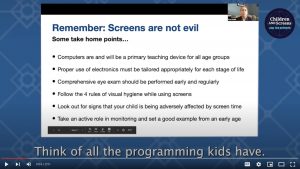
Vision is the dominant human sense, and 21st-century children find themselves growing up in a visual world filled with screens. Screens are what vision scientists call “near media.” That means that screens are typically looked at when they are close to our eyes.
Spending so much time looking at near media is not the norm for visual perception, which is a system evolved for processing scenes and objects at different depths. People spending time outdoors, for example, tend to focus on objects at different distances. The opposite is true of a child looking at a screen, who spends much more time looking at the close-up screen. Spending hours a day looking at a screen forces a child’s eyes to keep a constant eye position, as the screen rarely changes distance from the child’s face. This can alter how the eyes work and grow.
Screen-based Risks to Vision
- Myopia, or near-sightedness, is a common vision problem that usually begins between 6 and 14 years of age. Researchers have linked screen use to increased rates of myopia in children and teenagers. Experts believe that constant screen use may influence the growth of the eye, increasing the likelihood that myopia develops over time.
- “Computer vision syndrome,” sometimes called “digital eye strain,” is a condition involving head and neck pain in addition to vision issues. As screen overuse increases, so does the risk of developing this condition.
- “Convergence insufficiency” is the inability to maintain visual focus at a particular depth. Screen overuse has been linked to increased rates of this condition, which leads to increased blurriness and difficulty focusing on near media.
Behind the eyes, the developing visual system of the child’s brain also has to process the unique properties of screens. When compared to the visual statistics the brain gets from more 3-dimensional visual environments, screens are like a caricature. They are brighter, more rectangular at every scale, closer-up, more rewarding, and better at keeping kids’ attention than other parts of the visual environment. The developing brain may grow to expect these exaggerated properties and organize visual behavior around seeking them, paving the way for future screen use. Additionally, the various aspects of visual inputs from screens reduce the quality and duration of children’s sleep.
Protecting Young Eyes
To enhance visual health and wellness, experts caution children to reduce screen exposure and spend time every day in more natural and varied visual environments. This can help counter the negative effects of screen-based near-media on visual health. If any of the ocular health issues above are of concern, experts suggest that screen-based experiences may be replaced with real-world experiences whenever possible.
When children are reading on screens, larger font sizes may reduce eye strain. The minimum font size for online reading should be 18 pt on smartphones, 16 pt on computers, 10.5 pt on tablets, and 9 pt on paper.
While less screen time is easier on the eyes and brain, older kids required to use screens for educational purposes may benefit from using the “20/20/20 rule.” The 20/20/20 rule recommends a 20-second break to look at something 20 feet away every 20 minutes.
Look for signs that your child is being adversely affected…if they’re blinking too much, if they’re rubbing their eyes, if they’re getting headaches. Take an active role in monitoring your child.










